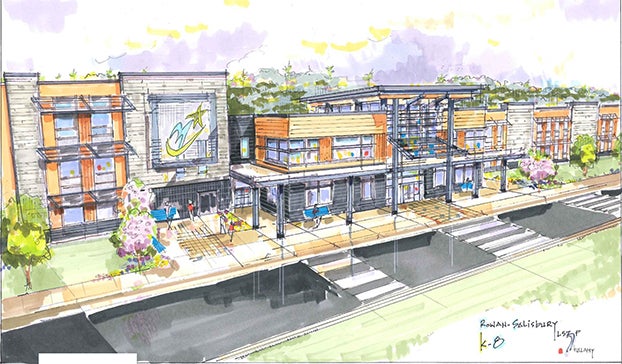Ask Us: What problems would combined Knox-Overton K-8 solve?
Published 2:00 pm Monday, February 21, 2022

- A conceptual drawing of the Knox-Overton K-8 school that's proposed to be built between the two facilities in Salisbury. and the firm LS3P.
Editor’s note: Ask Us is a weekly feature published online Mondays and in print on Tuesdays. We’ll seek to answer your questions about items or trends in Rowan County. Have a question? Email it to askus@salisburypost.com.
SALISBURY — A reader asked how a new K-8 school would improve educational outcomes for students in Salisbury.
Rowan-Salisbury Schools faces a K-8 project with a price tag that jumped about $14 million because of an increase in material costs. But district officials say the school would be valuable on a few fronts.
The plan is to build the new facility between the existing Knox and Overton Elementary schools, effectively combining the two. The plan has gone through a few iterations. The RSS Board of Education initially planned to heavily renovate Knox and demolish Overton, but the board approved a plan to build a new school after community backlash.
The original plan for the K-8 included demolishing Knox and Overton, but the board is expecting to decide on the fate of Overton later this month.
The original plan to renovate Knox carried a $26 million price tag. The K-8 school when approved in 2020 had a $55 million estimate, but that climbed to $69.6 million.
There are, however, some savings tied into the schools. In addition to the tens of millions in capital needs assessed at Knox, Overton is carrying about $2 million of its own needs. RSS Chief Operations Officer Anthony Vann said closing the facilities would cross millions off the district’s running list of capital needs projects and discontinue their operational costs, too.
There are some design issues as well. If the district renovated Knox, it would not fix the fundamental issue of an open campus design.
School districts have moved away from open campus designs because they cause security problems.
“Open campuses are harder to contain as far as visitors and students going in and out,” Vann said.
Knox has more entrances than a school of the same size built today. Older schools also have problems with visibility. The new design has designated places staff could observe large areas within the school, and the number of corners is kept to a minimum for that reason.
Vann said renovations could fix issues such as enclosed walkways between buildings, but it would not be the same as building a school designed to today’s standards.
Vann said there is a tipping point where it is a better financial decision to build a new facility rather than refit an old building to what the district wants.
“It would be safe to say that by designing and moving into a new, modern facility that is designed for today’s teaching and learning, I think it would certainly be a benefit to our students and staff,” Vann said
Chief Academic Officer Jason Gardner said West Rowan Elementary School, the district’s newest facility, is the model for what the district can do with classroom space to best accommodate learning
“They have the ability to flex the learning space in the class room and reconfigure it based on student needs,” Gardner said. “And they have places in the school that are available for multi-classroom collaboration and things like that.”
Senior Marketing and Communications Officer Tracey Lewis said the district also has received good feedback from families about their pride in West Rowan Elementary improving from their previous schools.
Gardner said aesthetics of new facilities are important. He said research supports better student outcomes when they are in a clean, modern environment.
At the end of 2018 researchers from the UCLA California Policy Lab and U.C. Berkley published a paper outlining metrics on millions of students and showing a move to new facilities from those in disrepair produced increased test scores and improved attendance.



